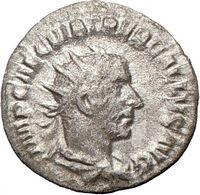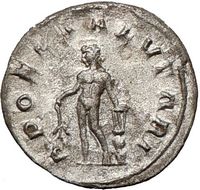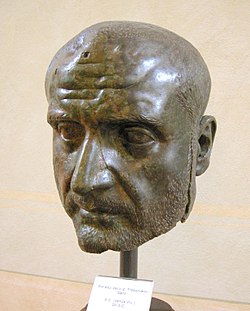Trebonianus Gallus Roman Emperor 251-253 A.D.
Biography Authentic Ancient Roman Coins Online Shop
Buy Trebonianus Gallus Roman Emperor Ancient Coins from a trusted
ancient coin dealer.
You can find more about Gordian II watching the vide below
 
Authentic Ancient Coin of:
Trebonianus Gallus - Roman Emperor: 251-253 A.D. -
Silver Antoninianus Rome mint: 251-253 A.D.
Reference: RIC 32, C 20
IMPCAECVIBTREBGALLVSAVG - Radiate, draped and cuirassed bust right.
APOLLSALVTARI - Apollo standing left, holding branch and lyre on rock.
Gaius Vibius Trebonianus Gallus (206 - August,
253), was
Roman Emperor from 251 to 253, in a
joint rule with his son
Volusianus.
Gallus was born in Italy, in a family with respected
ancestry of
Etruscan
senatorial background. He had two
children in his marriage with
Afinia Gemina Baebiana: Gaius Vibius
Volusianus, later Emperor, and a daughter, Vibia Galla. His early career
was a typical
cursus honorum, with several
appointments, both political and military. He was
suffect consul and in 250 was nominated
governor of the
Roman province of
Moesia Superior, an appointment that
showed the confidence of emperor
Trajan Decius in him. In Moesia, Gallus
was a key figure in repelling the frequent invasion attacks by the
Gothic tribes of the
Danube and became popular with the
army, catered to during his brief Imperial rule by his official image:
military haircut, gladiatorial physique, intimidating stance (illustration,
left).[1]
In June 251, Decius and his co-emperor and son
Herennius Etruscus died in the
Battle of Abrittus, at the hands of the
Goths they were supposed to punish for raids into the empire, largely
owing to the failure of Gallus to attack aggressively. When the army
heard the news, the soldiers proclaimed Gallus emperor, despite
Hostilian, Decius' surviving son,
ascending the imperial throne in Rome. Gallus did not back down from his
intention to become emperor, but accepted Hostilian as co-emperor,
perhaps to avoid the damage of another civil war. While Gallus marched
on Rome, an outbreak of
plague struck the city and killed young
Hostilian. With absolute power now in his hands, Gallus nominated his
son Volusianus co-emperor.
Eager to show himself competent and gain popularity
with the citizens, Gallus swiftly dealt with the epidemic, providing
burial for the victims. Gallus is often accused of persecuting the
Christians, but the only solid evidence
of this allegation is the imprisoning of
Pope Cornelius in 252.
Like his predecessors, Gallus did not have an easy
reign. In the East, Persian Emperor
Shapur I invaded and conquered the
province of
Syria, without any response from Rome.
On the Danube, the Gothic tribes were once again on the loose, despite
the peace treaty signed in 251. The army was not long pleased with the
emperor, and when
Aemilianus, governor of Moesia Superior
and Pannonia, took the initiative of battle and defeated the Goths, the
soldiers proclaimed him emperor. With a
usurper threatening the throne, Gallus
prepared for a fight. He recalled several
legions and ordered reinforcements to
return to Rome from the
Rhine frontier. Despite these
dispositions, Aemilianus marched onto Italy ready to fight for his
claim. Gallus did not have the chance to face him in battle: he and
Volusianus were murdered by their own
troops in August 253, in
Interamna (modern Terni).

Bronze of Gallus dating from the time of his reign
as Roman Emperor, the only surviving near-complete full-size 3rd
century Roman bronze (Metropolitan
Museum of Art)
|